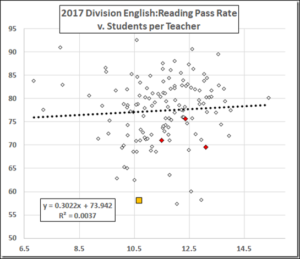
Among the most dismal of the Standards of Learning (SOL) results released last week by the Virginia Department of Education (VDOE) was that only 72% of 3rd graders had achieved reading proficiency — down 3% from the previous year ans 12% from a decade previously.
The usual suspects will respond to the news with the usual nostrums. Those on the left predictably will say that Virginia needs more money to (take your pick) hire teachers, pay teachers more, hire more counselors, or build newer, shinier school buildings. As an antidote to such thinking, contemplate the scatter graph above compiled by John Butcher on Cranky’s Blog.
In previous posts, Butcher has documented that there is very little correlation between per pupil expenditure and SOL achievement. In today’s post, he explores variations on the same theme, showing that there is minimal correlation on a school-district level between between the teacher-pupil ratio and SOL achievement in either reading or math.
In other scatter graphs, Butcher shows that there is even less correlation — essentially zero — between school size and reading/math SOL proficiency.
From the right side of the philosophical spectrum, as a Richmond Times-Dispatch editorial opines, come calls for more charter schools, more magnet programs, and more publicly and privately funded vouchers. While such alternatives may be appealing as a long-term solution, one has to be realistic that politically they are a non-starter in a state run by a Democratic Party governor and a legislature that likely will turn blue as well. Conservatives and libertarians should continue fighting for school choice, but in the meantime they need to proffer serious analysis of what ails public schools and what can be done to fix them — or at least not make them worse.
If the problem isn’t money, or teacher-pupil ratios, or school size, what is it? I think I’m getting closer to some answers. Let me sketch out my thinking at this point in time.
What really ails Virginia schools. Virginia’s public education system combines a toxic mix of three elements that interact in terribly dysfunctional ways: (1) the sociological reality of a large and growing population of children raised in material poverty, absentee fathers, substance abuse, child abuse and neglect, and other dysfunctions; (2) the spread of politically correct doctrine, manifested most recently in the imposition of “restorative justice” as a means of achieving school discipline; and (3) a push for accountability metrics, of which the SOLs are only one, that pressure school districts, principals, and teachers to game the system in order to show progress where none exists.
This combination is especially poisonous at schools with concentrated poverty. A number of things are going on. Schools are under pressure to reduce the rising rate of absenteeism — both the problem of students skipping school and the problem, among students who do come to school, of skipping class. The educrats seem to understand that it is a farce to claim that high school graduation rates are declining even while absenteeism is increasing. They also understand that students won’t learn (and pass their SOLs) if they don’t enter a classroom.
But the absenteeism-reduction imperative conflicts with the restorative-justice imperative. When kids skip school, there’s usually a reason — they’re bored and/or frustrated. They are bored and/or frustrated because they don’t understand the material, can’t participate meaningfully in class, and feel set up to fail. They feel all those things because they have been socially promoted to grades beyond their competence, a phenomenon that is itself the product of politically correct thinking.
So, Virginia schools now have more bored/frustrated kids sitting in classrooms. Some just tune out. But others act out, disrupting class. Here’s where the restorative justice approach to school discipline comes in. Schools subject to federal court order to reduce expulsions, suspensions, and other sanctions on the grounds that they disproportionately impact minorities typically have substituted a therapeutic approach. In Henrico County, I understand, teachers are first called upon to “de-escalate” a disruptive situation. If that doesn’t work, teachers are supposed to take the student into the hall and reason with them. If a student must be removed from class, the time can be 20 minutes, no longer. Following these steps consumes a significant percentage of the teacher’s time. (My source estimates that he spends about 25% of his class time dealing with disruptive students, more than ever.) The result is that teachers have less time to teach the majority of students who do want to learn and are willing to behave comport themselves properly…. which leads to lower SOL scores. Of course, as I have frequently observed, the victims of disruptive students are disproportionately minorities themselves.
Can things get worse? Yes, they can. This school year the VDOE is rolling out a new set of accreditation standards, which include a host of new performance processes and metrics. While the goal of establishing objective measures for holding schools accountable is laudable in the abstract, the new processes could mire schools in even more red tape, lead to more gamesmanship and data manipulation, empower those who figure out how to work the new rules and demoralize those who don’t. When placed in impossible situations, teachers, principals and school officials could be even more tempted to engage in ass-covering behavior to avoid sanctions that could hurt their careers. Virginia schools could plunge even deeper into self-deception and denial. That’s not a prediction, just a possible outcome — but one we should be alert to.
Consider yourself forewarned. More bureaucratic rules are rarely the answer to any complex problem.

Leave a Reply
You must be logged in to post a comment.